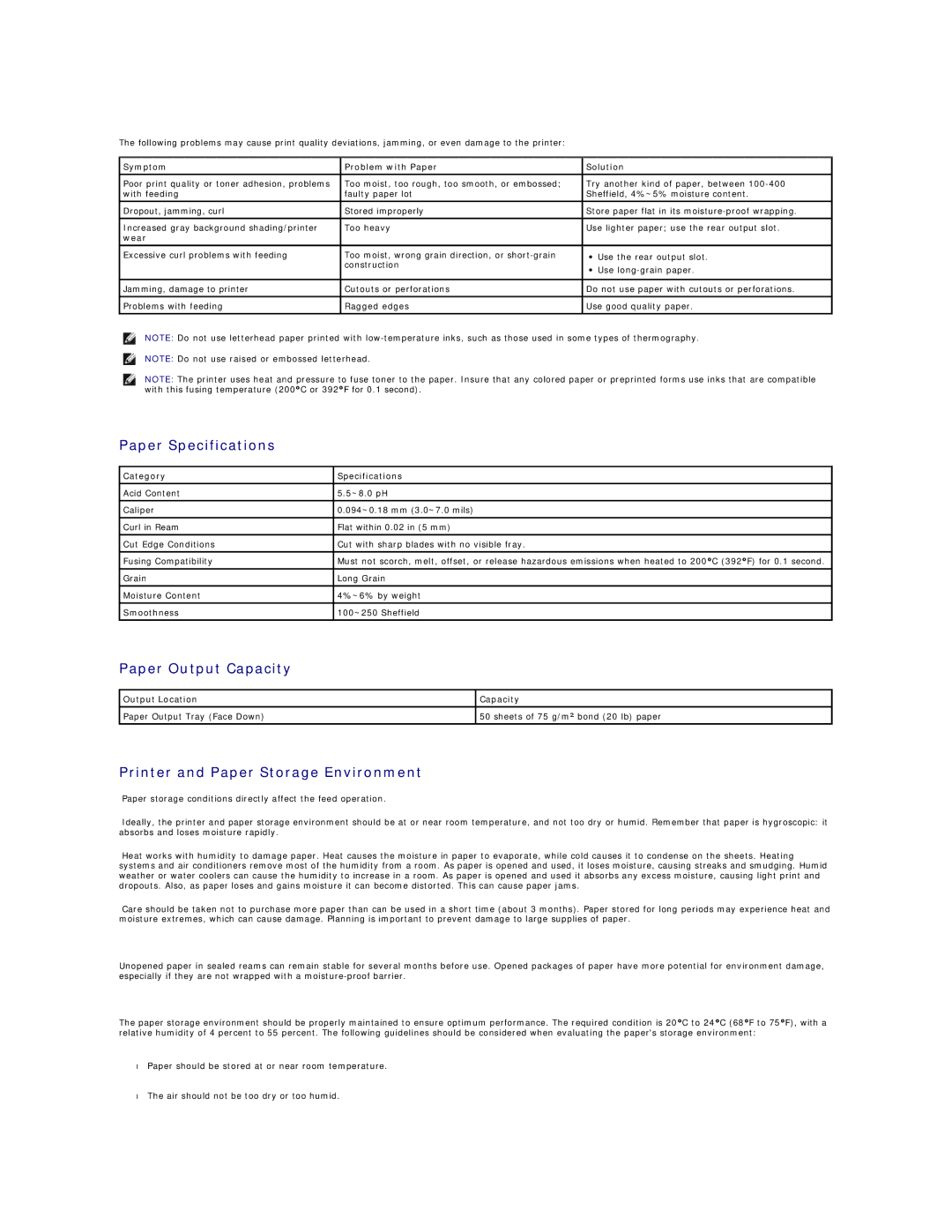The following problems may cause print quality deviations, jamming, or even damage to the printer:
Symptom | Problem with Paper | Solution |
|
|
|
Poor print quality or toner adhesion, problems | Too moist, too rough, too smooth, or embossed; | Try another kind of paper, between |
with feeding | faulty paper lot | Sheffield, 4%~5% moisture content. |
|
|
|
Dropout, jamming, curl | Stored improperly | Store paper flat in its |
|
|
|
Increased gray background shading/printer | Too heavy | Use lighter paper; use the rear output slot. |
wear |
|
|
|
|
|
Excessive curl problems with feeding | Too moist, wrong grain direction, or | • Use the rear output slot. |
| construction | • Use |
|
| |
|
|
|
Jamming, damage to printer | Cutouts or perforations | Do not use paper with cutouts or perforations. |
|
|
|
Problems with feeding | Ragged edges | Use good quality paper. |
|
|
|
NOTE: Do not use letterhead paper printed with
NOTE: Do not use raised or embossed letterhead.
NOTE: The printer uses heat and pressure to fuse toner to the paper. Insure that any colored paper or preprinted forms use inks that are compatible with this fusing temperature (200°C or 392°F for 0.1 second).
Paper Specifications
Category | Specifications |
|
|
Acid Content | 5.5~8.0 pH |
|
|
Caliper | 0.094~0.18 mm (3.0~7.0 mils) |
|
|
Curl in Ream | Flat within 0.02 in (5 mm) |
|
|
Cut Edge Conditions | Cut with sharp blades with no visible fray. |
|
|
Fusing Compatibility | Must not scorch, melt, offset, or release hazardous emissions when heated to 200°C (392°F) for 0.1 second. |
|
|
Grain | Long Grain |
|
|
Moisture Content | 4%~6% by weight |
|
|
Smoothness | 100~250 Sheffield |
|
|
Paper Output Capacity
Output Location | Capacity |
|
|
Paper Output Tray (Face Down) | 50 sheets of 75 g/m² bond (20 lb) paper |
|
|
Printer and Paper Storage Environment
Paper storage conditions directly affect the feed operation.
Ideally, the printer and paper storage environment should be at or near room temperature, and not too dry or humid. Remember that paper is hygroscopic: it absorbs and loses moisture rapidly.
Heat works with humidity to damage paper. Heat causes the moisture in paper to evaporate, while cold causes it to condense on the sheets. Heating systems and air conditioners remove most of the humidity from a room. As paper is opened and used, it loses moisture, causing streaks and smudging. Humid weather or water coolers can cause the humidity to increase in a room. As paper is opened and used it absorbs any excess moisture, causing light print and dropouts. Also, as paper loses and gains moisture it can become distorted. This can cause paper jams.
Care should be taken not to purchase more paper than can be used in a short time (about 3 months). Paper stored for long periods may experience heat and moisture extremes, which can cause damage. Planning is important to prevent damage to large supplies of paper.
Unopened paper in sealed reams can remain stable for several months before use. Opened packages of paper have more potential for environment damage, especially if they are not wrapped with a
The paper storage environment should be properly maintained to ensure optimum performance. The required condition is 20°C to 24°C (68°F to 75°F), with a relative humidity of 4 percent to 55 percent. The following guidelines should be considered when evaluating the paper's storage environment:
•Paper should be stored at or near room temperature.
•The air should not be too dry or too humid.
